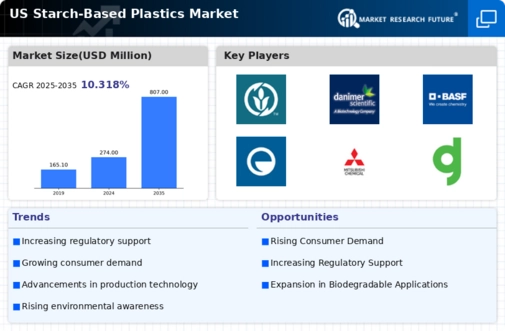The starch based-plastics market is currently characterized by a dynamic competitive landscape, driven by increasing consumer demand for sustainable materials and regulatory pressures aimed at reducing plastic waste. Key players such as NatureWorks LLC (US), BASF SE (DE), and Cargill Inc (US) are strategically positioned to leverage their technological advancements and extensive supply chains. NatureWorks LLC (US) focuses on innovation in biopolymer production, while BASF SE (DE) emphasizes partnerships to enhance its product offerings. Cargill Inc (US) is actively pursuing regional expansion to meet local market needs, collectively shaping a competitive environment that prioritizes sustainability and innovation.
In terms of business tactics, companies are increasingly localizing manufacturing to reduce transportation costs and enhance supply chain efficiency. The market appears moderately fragmented, with several players vying for market share. However, the collective influence of major companies is significant, as they drive trends in sustainability and technological advancements, thereby shaping the overall market structure.
In October 2025, NatureWorks LLC (US) announced a partnership with a leading packaging company to develop a new line of compostable packaging solutions. This strategic move is likely to enhance NatureWorks' market position by expanding its product portfolio and addressing the growing demand for environmentally friendly packaging options. The collaboration underscores the importance of partnerships in fostering innovation and meeting consumer expectations for sustainable products.
In September 2025, BASF SE (DE) launched a new range of starch-based bioplastics aimed at the automotive sector. This initiative reflects BASF's commitment to diversifying its applications and tapping into the automotive industry's shift towards sustainable materials. The introduction of these bioplastics could potentially position BASF as a leader in this niche market, aligning with broader industry trends towards sustainability.
In August 2025, Cargill Inc (US) expanded its production capacity for starch-based plastics in response to increasing demand from the food packaging sector. This expansion is indicative of Cargill's proactive approach to scaling operations and enhancing its competitive edge. By increasing production capacity, Cargill is likely to solidify its market presence and respond effectively to the evolving needs of its customers.
As of November 2025, the competitive trends in the starch based-plastics market are increasingly defined by digitalization, sustainability, and the integration of advanced technologies such as AI. Strategic alliances are becoming more prevalent, as companies recognize the need to collaborate to innovate and meet regulatory demands. Looking ahead, competitive differentiation is expected to evolve, shifting from price-based competition to a focus on innovation, technological advancements, and supply chain reliability. This transition may redefine market dynamics, emphasizing the importance of sustainable practices and product innovation.





















Leave a Comment